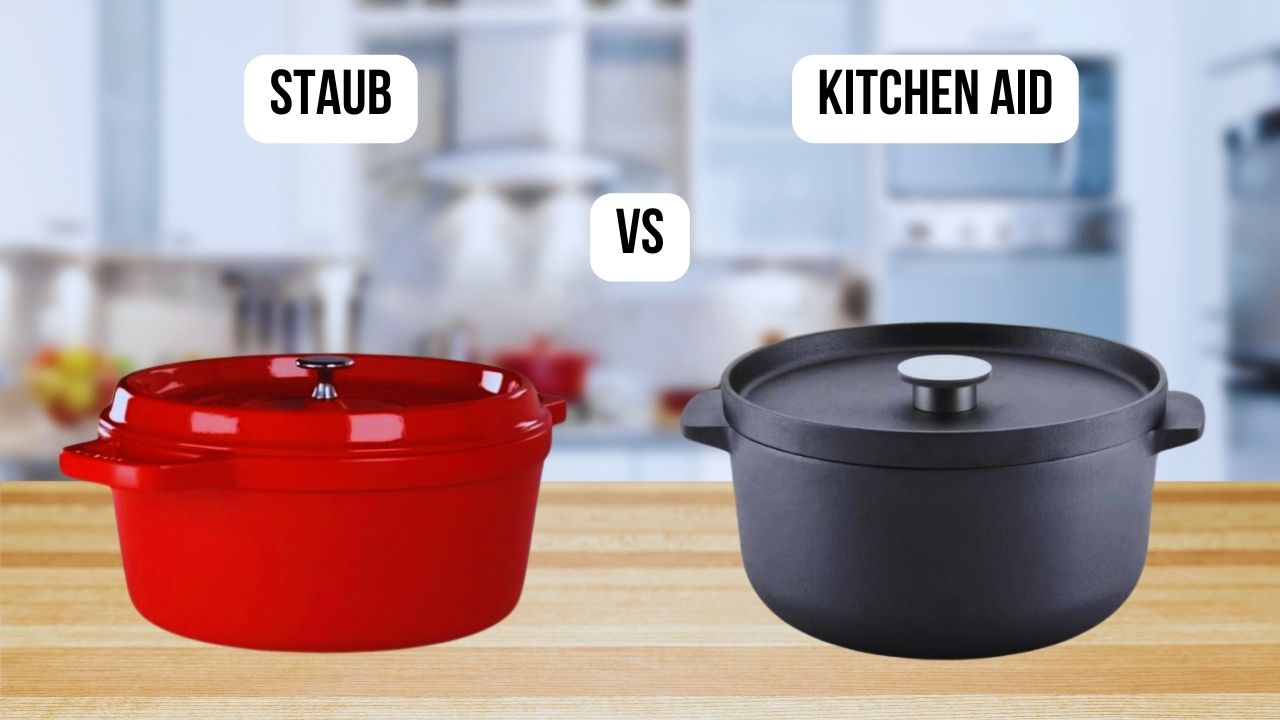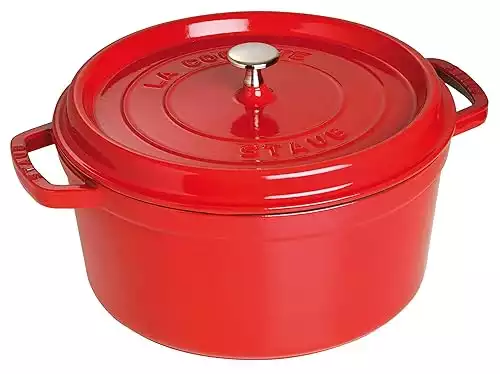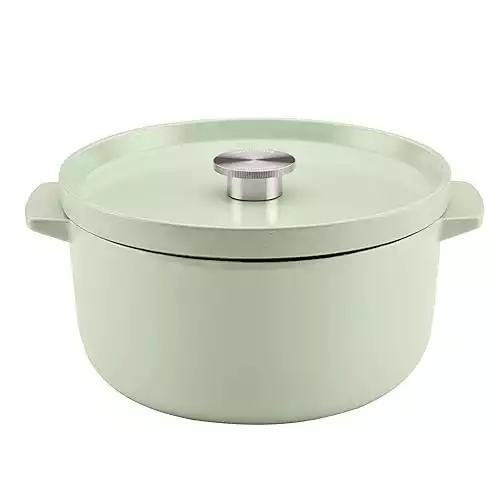As a seasoned restaurant chef with a decade of experience, I’ve honed my skills in selecting the best kitchen equipment, crucial for creating top-notch dishes. Among these, Dutch ovens are indispensable. In this article, we delve into a detailed comparison of two renowned Dutch ovens: the KitchenAid Dutch Oven and the Staub Dutch Oven. Our aim is to guide you in choosing the one that best fits your culinary needs.
This comparison is structured around key factors that define the quality of a Dutch oven:
- Material
- Weight
- Heat retention and compatibility
- Lid fit
- Handles and product design
- Colors
- Maintenance and cleaning
- Durability and performance
- Warranty
- Price
|
Our Rating:
3.9
|
Our Rating:
3.1
|
|
Pros:
|
Pros:
|
|
Cons:
|
Cons:
|
- Better material
- Better heat retention
- Tight-fitting lid
- Stylish and aesthetically pleasing design
- Easy to maintain
- Better durability and performance
- Lifetime warranty
- Heavier
- Ergonomic handles, but a bit narrow
- Not the most budget-friendly option
- Weight is manageable
- Good heat retention capabilities
- More affordable
- Worse material
- Minor issue with lid stability
- Handles lack secure grip holes
- The enamel may become chipped
- Less robust and substantial compared to premium options
- One-year warranty
Staub is a popular premium cookware brand, often compared to Le Creuset. I purchased the Staub 5-quart Round Cocotte Dutch Oven and was excited to try it out.
KitchenAid is a renowned kitchen appliance brand known for its premium-quality products. Their Enameled Cast Iron Dutch Oven is a popular choice for cooking enthusiasts. This Dutch oven offers functionality and aesthetic appeal, making it a trusted brand for culinary enthusiasts and home chefs.
Staub has achieved recognition as one of the TOP-5 options of sutch ovens on the market.
We’ll explore each aspect of these Dutch ovens, putting them to the test in a practical cooking scenario. This will give us a clear picture of how each performs in a real kitchen setting, enabling you to make an informed decision for your cooking adventures.
In this review, I provide an independent assessment of the pros and cons of Staub and KitchenAid, based on my experience as a chef. If you choose to purchase it, please consider using the referral links included in this article. I earn a small commission from your purchases at no additional cost to you, which helps support this blog. Thank you!
Staub VS Kitchen Aid: Material
| Staub | KitchenAid |
|---|---|
| Staub Dutch Ovens are constructed from high-quality cast iron, which is renowned for its excellent heat retention and even heat distribution. The interior is coated with an enamel glaze that prevents rust and food from sticking. | The KitchenAid Dutch oven is made of cast iron with an enamel coating. It offers a robust and rust-resistant build. However, I find its cast iron thickness slightly less substantial than other Dutch oven brands. |
Staub VS Kitchen Aid: Weight
| Staub | KitchenAid |
|---|---|
| Staub Dutch Ovens tend to be on the heavier side due to their cast iron construction. While this weight is excellent for retaining heat, it might be a concern for those who prefer lightweight cookware. | This Dutch oven‘s weight is manageable. It can be easily lifted and maneuvered even if loaded with food. |
Staub VS Kitchen Aid: Heat Retention and Compatibility
| Staub | KitchenAid |
|---|---|
| The Staub Dutch Oven excelled in heat retention. It maintains the temperature throughout the cooking process consistently. It is versatile and suitable for various cooking methods. It performed exceptionally well on both the stovetop and oven. | The KitchenAid Dutch oven demonstrated good heat retention capabilities, maintaining a consistent temperature during braising for optimal results. Additionally, its wide heat compatibility, suitable for various stovetops and oven use up to 500 degrees Fahrenheit, ensures versatility in cooking methods. |
Staub VS Kitchen Aid: Lid Fit
| Staub | KitchenAid |
|---|---|
| The tight-fitting lid in Staub Dutch Ovens ensures a snug seal, trapping moisture and flavor inside the pot, making it ideal for long-simmering dishes. | The self-basting lid creates an effective seal to retain moisture and flavor in the Dutch oven. However, there’s a minor issue with lid stability, causing steam leakage when the pot is moved, especially during extended cooking sessions. |
Staub VS Kitchen Aid: Handles and Product Design
| Staub | KitchenAid |
|---|---|
| The Staub Dutch Oven features ergonomic handles, although I find the space a bit narrow. It makes it slightly challenging to lift the pot, especially when wearing oven mitts. Despite this handle design concern, the Dutch Oven’s overall product design is stylish and aesthetically pleasing. Its striking enameled exterior adds an elegant touch to the kitchen, making it a versatile piece suitable for cooking and serving. | The Dutch oven’s side handles lack secure grip holes, making it challenging to hold firmly. Despite this, the overall design is elegant and minimalistic, making it visually appealing for serving dishes. |
Staub VS Kitchen Aid: Colors
| Staub | KitchenAid |
|---|---|
| Staub offers various elegant and vibrant colors to match your kitchen decor. | The KitchenAid Enameled Cast Iron Dutch Oven is available in a few color options, such as pistachio and blue velvet. The color choices are relatively limited compared to other Dutch ovens that offer a more extensive selection of shapes, sizes, and colors. |
Staub VS Kitchen Aid: Maintenance and Cleaning
| Staub | KitchenAid |
|---|---|
| Maintaining the Staub Dutch Oven is a breeze. The enamel interior is resistant to staining and remarkably easy to clean. After hours of slow-cooking the short ribs, I only needed a brief soak and a gentle scrub to have it looking as good as new. | Cleaning the KitchenAid Dutch oven is easy due to its enamel coating, but it displayed signs of chipping after a few uses. |
Staub VS Kitchen Aid: Durability and Performance
| Staub | KitchenAid |
|---|---|
| Staub Dutch Ovens are renowned for their durability and performance. They can last a lifetime if well-maintained and are a chef’s favorite for slow-cooked stews and braises. | The KitchenAid Dutch oven performed adequately for a specific cooking task but felt less robust and substantial compared to premium options. It’s suitable for occasional home use but may not be as durable for professional kitchen demands. |
Staub VS Kitchen Aid: Warranty
| Staub | KitchenAid |
|---|---|
| Staub provides a lifetime warranty with certain limitations for their cast iron cookware. This warranty addresses functional, material, and manufacturing defects found in cast iron cookware. | This Dutch oven includes a one-year warranty for added reassurance regarding its durability. Nevertheless, it is best to invest in high-end brands that offer better value for the price. |
Staub VS Kitchen Aid: Price
| Staub | KitchenAid |
|---|---|
| Staub Dutch Ovens are an investment with a price point that reflects their quality. They may not be the most budget-friendly option, but their longevity and performance make them worth it. | The KitchenAid Dutch Oven is affordable. |
Cooking Test
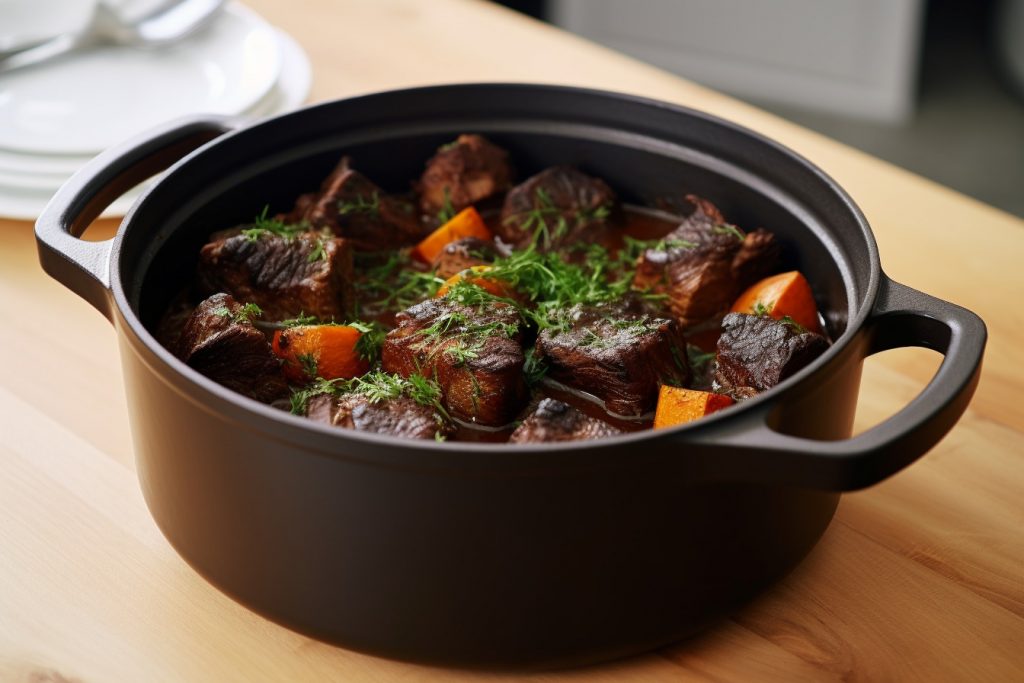
I conducted a cooking test to compare the performance of the KitchenAid and Staub Dutch ovens while preparing Red Wine Braised Short Ribs. The evaluation included the following criteria:
Browning
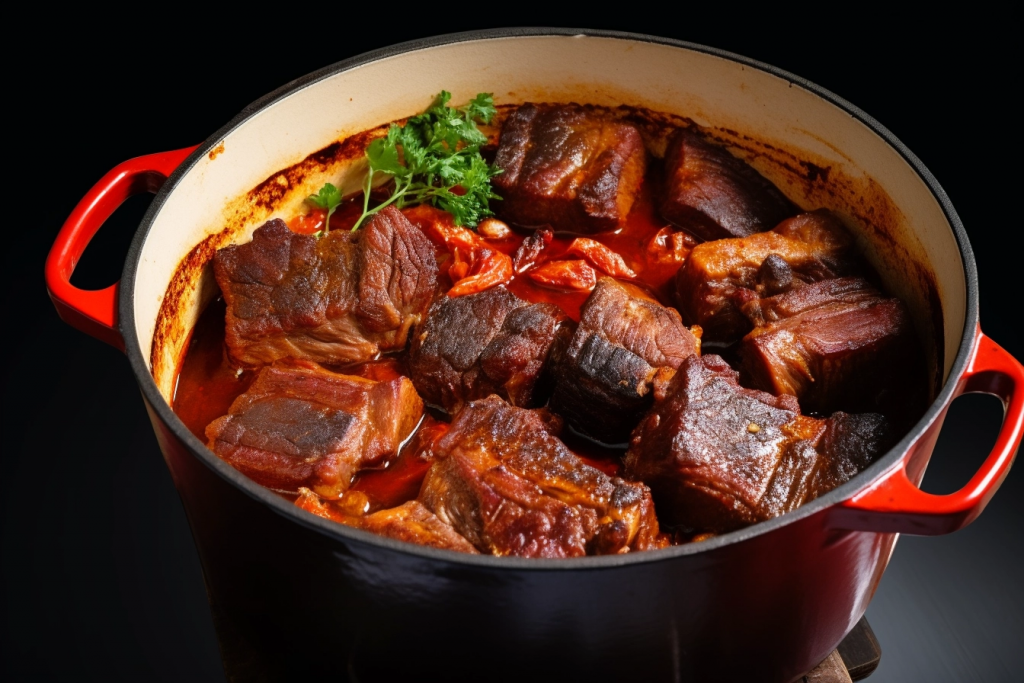
Both the KitchenAid and Staub Dutch ovens exhibited outstanding browning capabilities. Their cast iron construction enabled a flawless sear on all sides of the short ribs, resulting in a rich caramelized crust that contributed depth and complexity to the dish.
Moisture Retention
Braising revolves around the preservation of moisture within the dish. I meticulously observed the moisture retention capabilities of each Dutch oven throughout the slow cooking process. Maintaining a steady and moist environment is essential for achieving succulent and tender short ribs.
In this aspect, the Staub Dutch Oven truly excelled. The resulting ribs were notably more tender and juicier. The texture was also remarkably smooth, harmonizing perfectly with the other ingredients.
Final Flavor
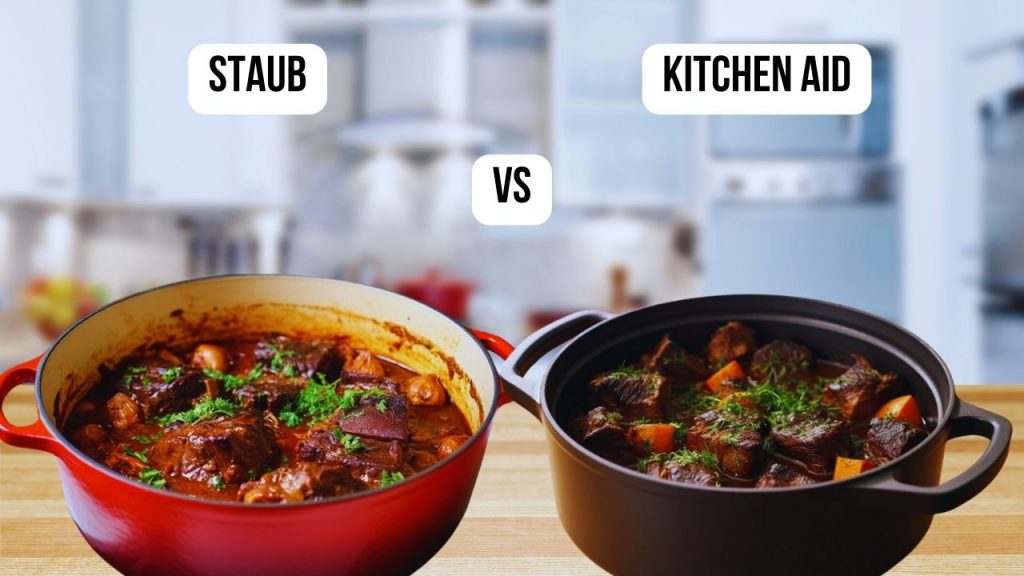
Although the ultimate flavor of the Red Wine Braised Short Ribs was outstanding in both Dutch ovens, it’s worth noting that the short ribs from the Staub Dutch Oven were even more tender and bursting with flavor.
How We Tested
The cooking test aimed to provide a comprehensive assessment of both Dutch ovens in a real cooking scenario.
To begin, we positioned the KitchenAid and Staub Dutch ovens side by side on the stovetop, heating them to the desired temperature. Subsequently, we proceeded to evenly sear and brown the short ribs in both Dutch ovens, closely observing their ability to distribute heat evenly and achieve a flavorful sear on the meat.
Throughout the slow-cooking phase, we meticulously monitored the moisture retention capabilities of the Dutch ovens. We placed particular emphasis on how effectively their lids sealed and preserved the desired level of steam and moisture within the dish.
Upon reaching the recommended cooking duration, we conducted a thorough taste test. This evaluation encompassed an assessment of the tenderness, flavor, and overall quality of the Red Wine Braised Short Ribs prepared in each Dutch oven.
Conclusion: Staub is The Winner
|
Our Rating:
3.9
|
Our Rating:
3.1
|
|
Pros:
|
Pros:
|
|
Cons:
|
Cons:
|
- Better material
- Better heat retention
- Tight-fitting lid
- Stylish and aesthetically pleasing design
- Easy to maintain
- Better durability and performance
- Lifetime warranty
- Heavier
- Ergonomic handles, but a bit narrow
- Not the most budget-friendly option
- Weight is manageable
- Good heat retention capabilities
- More affordable
- Worse material
- Minor issue with lid stability
- Handles lack secure grip holes
- The enamel may become chipped
- Less robust and substantial compared to premium options
- One-year warranty
In conclusion, after a thorough and practical evaluation of the KitchenAid and Staub Dutch ovens, it’s clear that the Staub Dutch Oven emerges as the winner in this culinary showdown.
Through a practical cooking test featuring Red Wine Braised Short Ribs, we assessed critical aspects such as browning, moisture retention, and final flavor. Both Dutch ovens exhibited impressive browning capabilities, thanks to their cast iron construction, which ensured a delightful caramelized crust on the short ribs.
For those who seek culinary excellence and are willing to invest in premium quality, the Staub Dutch Oven stands as the clear choice. Its exceptional performance, particularly in moisture retention and flavor enhancement, makes it the ideal companion for passionate home chefs and culinary enthusiasts alike. When it comes to elevating your cooking experience, the Staub Dutch Oven proves itself as a worthy investment that will enhance your culinary creations for years to come.
However, if you are looking for an affordable Dutch oven for home cooking, then, Staub might be a good option for you. If you decide to purchase it, please use my referral link.
Take a moment to browse through the list of the best Dutch ovens.

